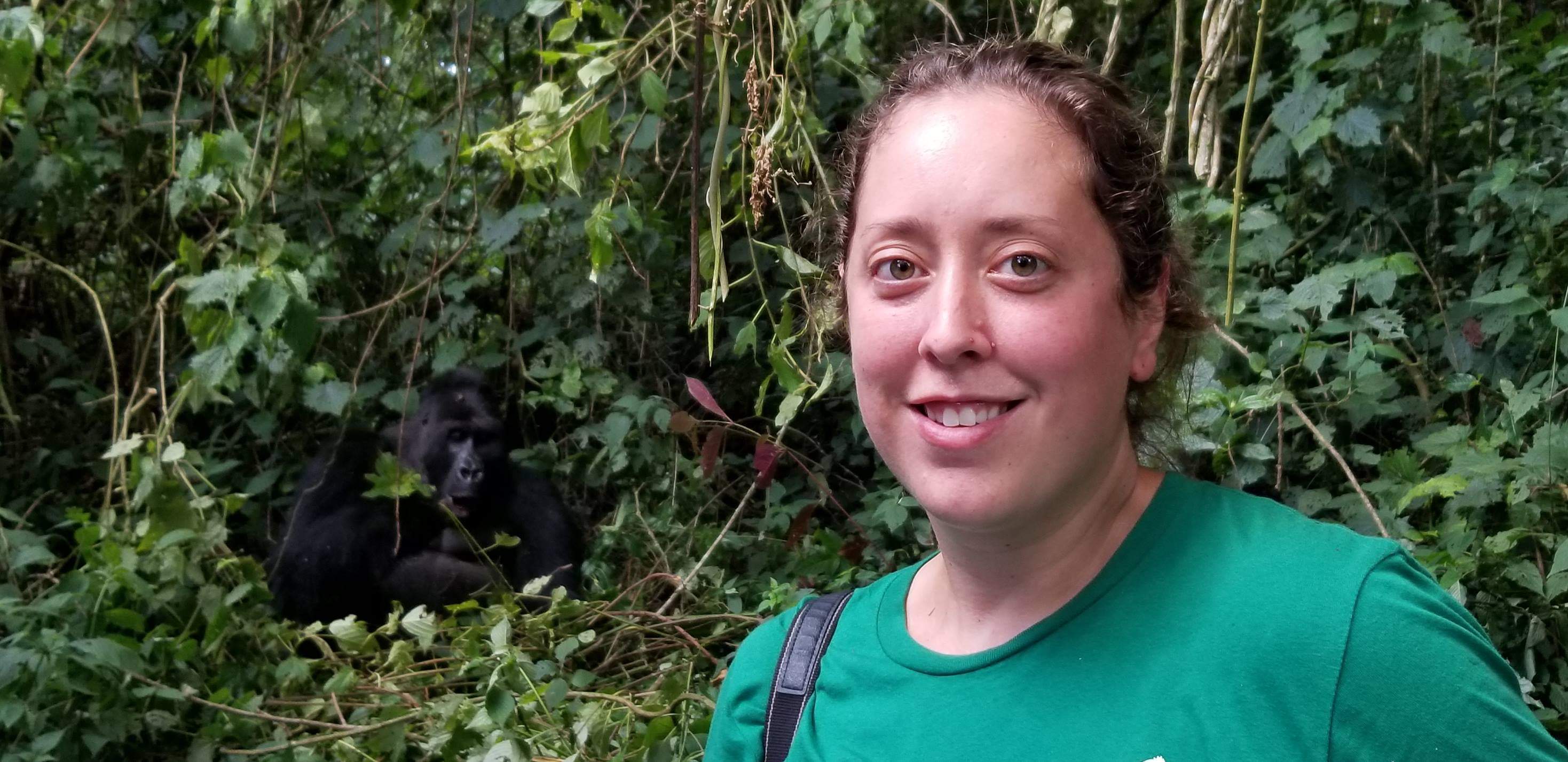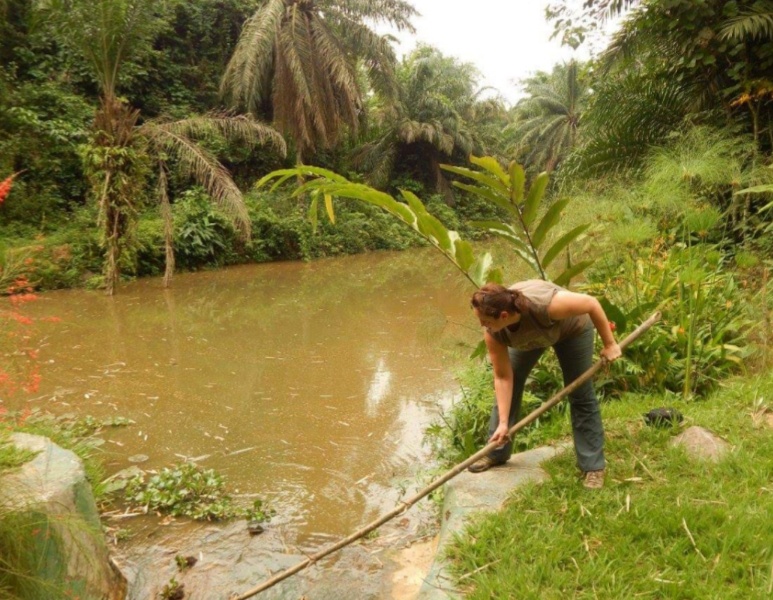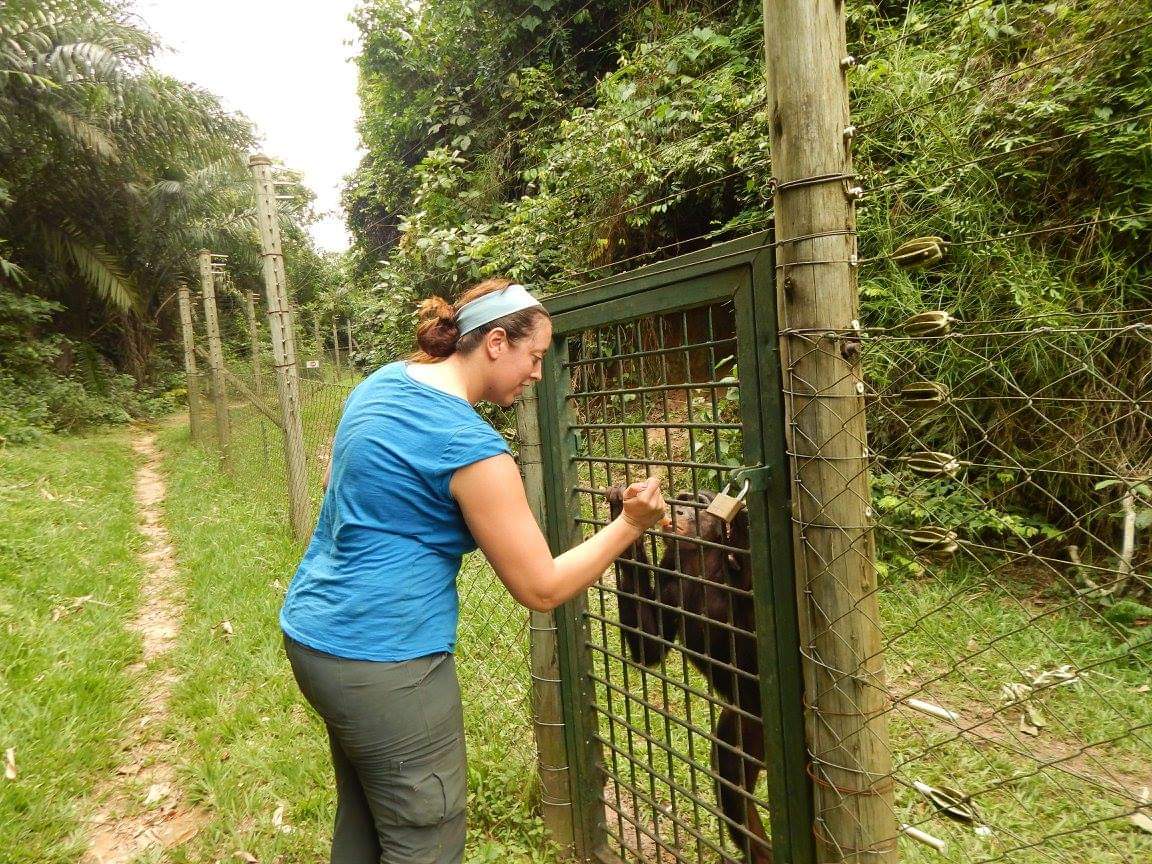Volunteer Spotlight: Meet Natasha
Long-term volunteer Natasha Tworoski shares her thoughts on PASA, the importance of sanctuaries, and how she got involved in the fight to protect primates.
Natasha Tworoski joined the PASA team as a volunteer in 2017. She is a regular contributor to the PASA blogs.
If you’d like to learn more about how to volunteer with PASA, click here for more information. If you are interested in volunteering in Africa at one of our member organizations, click here.

Natasha and a Grauer’s gorilla in Kahuzi Biega National Park.
How did you first learn about PASA, and what interested you in volunteering?
I heard of PASA after visiting a few primate sanctuaries in Africa, but learned just how much the organization was accomplishing when I met the director, Gregg Tully, at a bonobo workshop in 2017. The two-day event was a meeting of bonobo researchers, conservationists, caretakers, and educators who met to discuss how we could work to promote this endangered, but not well-known ape species. After Gregg explained how PASA does not just accredit sanctuaries, but also offers emergency funding to members, educational workshops for sanctuary staff, assists in the logistics of getting rescued primates to PASA sanctuaries and so much more, I knew I wanted to get involved. I emailed Gregg the next day to ask how I could help. Soon after, I started assisting with social media posts and writing blogs for the PASA website.
What is your favorite thing about volunteering for PASA?
I like knowing the current events of primate conservation and being involved with PASA keeps me engaged with that. I’ve attended the annual Strategic Development Conferences where PASA funds the directors from each member sanctuary to travel to one of the sanctuaries and discuss the challenges and successes they have had over the past year. Some of the sanctuary directors have had their role for decades and are a wealth of knowledge and experience. I’m interested in becoming more involved with sanctuaries on the ground, so attending these conferences has been very valuable for me. However, even the email updates PASA sends out to volunteers on the current happenings of the sanctuaries is a wealth of information. I am proud to be a small part of an organization that accomplishes so much.
Why is helping primate sanctuaries important?
Across the world, wildlife is disappearing at an alarming rate. The UN recently released a report that 1 million species are now at risk of becoming extinct due to human activity. That is an overwhelming number and an overwhelming problem. In order to stop this from happening, there needs to be people offering solutions on the front lines. While privately owning primates or smuggling infants to sell as pets is illegal, many governments in African countries have little motivation to enforce these laws without facilities to place rescued primates. Sanctuaries offer an invaluable solution to this problem and additionally can assist government officials in locating offenders. The reason sanctuaries are often the first to hear about animals in need of rescuing is they get local tips, usually from children. PASA sanctuaries will send educators out to surrounding neighborhoods to teach about wildlife and conservation, bringing to light the urgency of protecting the last remaining wild spaces. Many sanctuaries also allow school groups and the general public to come observe their rescued primates.
There is a famous quote by Baba Dioum that says, “In the end we will conserve only what we love, we will love only what we understand, and we will understand only what we are taught.” Watching a group of monkeys play together or hearing chimpanzees get excited when they know food is coming is an unforgettable experience, especially when you have never seen those animals before. Visitors to sanctuaries leave feeling compassion and are much more likely to take steps to stop the destruction, whether that be by reporting a smuggled monkey or no longer viewing endangered apes as a delicacy. Lastly, many PASA sanctuaries are working hard to preserve remaining wild spaces, either by buying the land themselves or working with local politicians to prioritize the efforts. This will offer protection to not only primates, but all other wildlife that shares these forests. It is important we support primate sanctuaries because of the ripple effect they create for wildlife conservation efforts.

Natasha clears debris in the river at Lola ya Bonobo.

Natasha’s veterinary experience comes in handy as she medicates a bonobo at Lola ya Bonobo.
What is your favorite African primate?
While gorillas have been one of my favorite animals since childhood, I have great admiration for baboons. As human populations continue to grow and development spreads, baboons are one of those few species who can adapt and find ways to thrive along humans. While this sometimes makes them unpopular, baboons just keep doing what they do. When I spent some time in Uganda working on a wild chimpanzee study after graduate school, it was very important that all of us kept our doors locked. However, it wasn’t because of the chimpanzees, but rather the baboons who would come through camp to test the door knobs and try to get inside in hopes of finding food. I also really like that baboon fathers play a more direct role in their offspring’s care, which isn’t the case in many primate species.
What is your favorite memory of your visits to Africa?
It is hard to pick just one! My first time to Africa I went to Uganda and arrived at sunset. I hired a driver at the airport to take me to my hostel and shortly after we got on the road, a Lady Ross’ turaco, one of my favorite bird species, flew alongside my car window for 10 seconds and I remember feeling such an intense surge of excitement, realizing I was finally in Africa. On that same trip, I later went to Rwanda and saw wild mountain gorillas and Dian Fossey’s original field site at Karisoke. I read her book Gorillas in the Mist when I was a kid, and it really changed my life. When I was with the gorillas, a female named Umurima walked up to me and leaned in to check me out. She had an infant on her back and a juvenile tagging along behind. After a few seconds she walked away and sat down to forage nearby. The juvenile stayed back and grabbed a vine on a nearby tree and started swinging towards me playfully before getting distracted by something else and somersaulting away. That was a pretty phenomenal moment.
